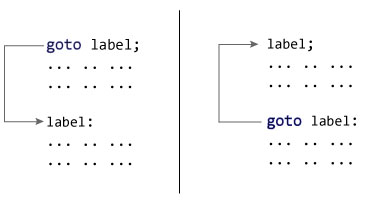
In C++ programming, goto statement is used for altering the normal sequence of program execution by transferring control to some other part of the program.
SYNTAX FOR GOTO STATEMENT:
goto label; ... .. ... ... .. ... ... .. ... label: statement; ... .. ...
In the syntax above, label is an identifier. When goto label; is encountered, the control of program jumps to label: and executes the code below it.

Example: goto Statement
// This program calculates the average of numbers entered by user.
// If user enters negative number, it ignores the number and
// calculates the average of number entered before it.
# include <iostream>
using namespace std;
int main()
{
float num, average, sum = 0.0;
int i, n;
cout << "Maximum number of inputs: ";
cin >> n;
for(i = 1; i <= n; ++i)
{
cout << "Enter n" << i << ": ";
cin >> num;
if(num < 0.0)
{
// Control of the program move to jump:
goto jump;
}
sum += num;
}
jump:
average = sum / (i - 1);
cout << "\nAverage = " << average;
return 0;
}
Output
Maximum number of inputs: 10 Enter n1: 2.3 Enter n2: 5.6 Enter n3: -5.6 Average = 3.95
You can write any C++ program without the use of
goto statement and is generally considered a good idea not to use them.Reason to Avoid goto Statement
- The goto statement gives power to jump to any part of program but, makes the logic of the program complex and tangled.
- In modern programming, goto statement is considered a harmful construct and a bad programming practice.
- The goto statement can be replaced in most of C++ program with the use of break and continue statements.
